Published
on 10
Nov 2022
|
All rights reserved.
|
|
|
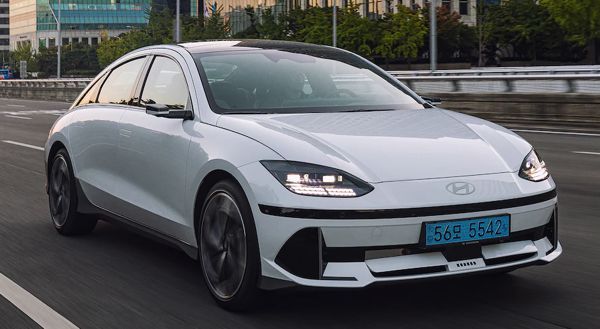
|
|
It
could have been the worst nightmare to Tesla Model 3, somehow...
|
|
Like most other legacy car
makers, Hyundai group enters EV market with crossovers first. Crossover
is not only the most popular type of vehicles currently on the market
but is also easier to be converted to pure electric power. Although
Tesla and Lucid demonstrated that a state of the art electric car can
be more space-efficient than conventional ICE cars, manufacturers with
less expertise and experience in this field usually fail to package all
the batteries, power electronics and motors in the same space as ICE
cars. Putting the heavy batteries under floor is the best solution to
save space and optimize handling, but doing so will inevitably raise
the cabin and the overall height of the car, unless you can make the
skateboard platform as thin as Tesla and Lucid do. That’s why they opt
for crossovers first. However, having rolled out the first wave of EV
in the form of Ioniq 5 and Kia EV6, Hyundai needs to expand into
conventional sedans. Unfortunately, the resultant Ioniq 6 employs the
same G-EMP platform of those crossovers…
2 and a half years ago, Hyundai unveiled an impossibly beautiful
concept car called Prophecy. It is a 4-door saloon, but so streamline
and beautiful that you can mistake it with the next generation Porsche
911. If Porsche thought of such design earlier, its 989 four-door
project could have escaped from axe and become a commercial hit. The
Prohecy was said to preview the Ioniq 6, so it sent a promising message
and raised our expectation for the Ioniq 6. If the production car ended
up half as good-looking, it would be the worst nightmare to Tesla Model
3…
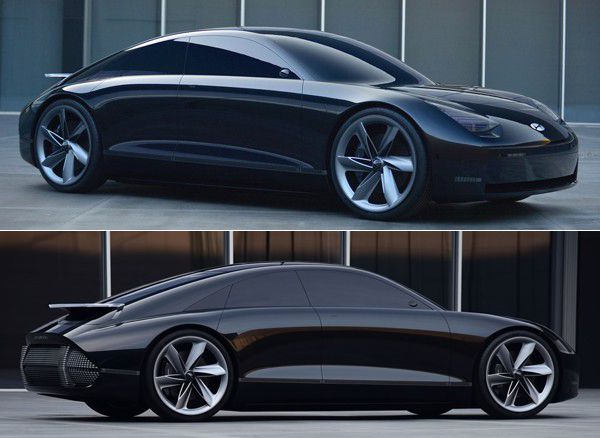
|
|
The
beauty of Prophecy concept fails to repeat on Ioniq 6.
|
|
Yes, considering the high level of polish and specifications of Ioniq 5
and EV6, the Ioniq 6 should have a good chance to technical knockout
Tesla. It has 350kW quick charging capability that allows 10-80 percent
charge in 18 minutes. It offers a maximum driving range of 382 miles or
614 km, longer than even the longest travelling Model 3. Moreover, in
dual-motor performance form, it is good for 585 horsepower, compared
with 450 hp of Model 3 Performance. Finally, it goes without saying
Hyundai’s build quality, reliability and attention to details are far
superior to Tesla. Ditto warranty and aftersales services. The Ioniq 6
could be the terminator of Tesla. Somehow, all these expectations fail
to materialize.
So what’s wrong with the Ioniq 6? Proportion. The Prophecy could mimic
a 911 because it is low, no matter roofline or waistline. Its
pronounced shoulders deliver a sports car stance, while a relatively
long nose and kamm tail enhance the sense of sleekness. The production
Ioniq 6 tries to retain the same shape, but there are too many physical
constraints prevent it from achieving the same visual effect. First of
all, it has to fit into practical dimensions for its class, so the nose
and tail are shortened, and the sides lose the muscular shoulder line.
Secondly, it has to reuse the not-so-thin skateboard floorpan of G-EMP.
Unlike Porsche Taycan, it does not carve out the footwell to help
lowering the seats, that’s why it stands at least 100 mm taller than it
should. Being shorter, narrower and taller, the 911 pretension ended up
closer to a Volkswagen Beetle.
Some said its rear spoiler gives it a 911 look. If so, you might say
that as well to a weird Saab 900
Turbo.
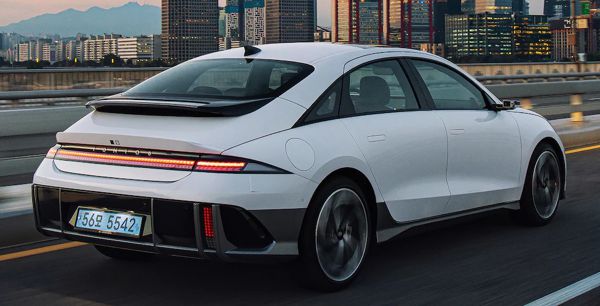
|
|
A
4-door 911? Hyundai's take on Mercedes CLA / CLS? An Ur Audi TT sedan?
It has a bit of them all.
|
|
Some said its side view looks like a Mercedes CLS or CLA. True, but the
Mercedes are not just sleeker, but their slim, flush and almost
invisible B-pillars give a better impression of a 4-door coupe. Maybe
due to production cost concern, the Hyundai lacks the precision and
polish of Mercedes design to realize the ambition of Prophecy.
Having said that, the Ioniq 6 is still an interesting design. Even more
graphical and dramatic than the Mercedes. A bit boring to view from the
front, far more interesting from the rear. The pixelated headlights and
taillights are stylish. In my opinion, it is not exactly a 4-door 911,
but an excellent imagination of a 4-door Ur Audi TT. It is that funky.
Apart from funky, it is also very aerodynamic efficient. Coefficient of
drag is 0.21, trailing only Mercedes EQS. Admittedly, it is achieved
with the help of optional rearview cameras instead of door mirrors.
In fact, the Ioniq 6 is shaped to maximize driving range. As it shares
the underpinnings with Ioniq 5, the only way it can beat Tesla for
range is by optimizing aerodynamics. The aforementioned 382 miles range
measured under WLTP method is no match for Mercedes EQS’ 477 miles or
EQE’s 397 miles, but it is achieved with a significantly smaller, 77.4
kWh battery. It goes without saying that a superior range figure is a
strong selling point on showroom level, but those figures usually don’t
reflect the real-world performance, because WLTP cycles include a lot
of highway cruising, which amplifies the importance of aerodynamics.
The fact that Mercedes and Hyundai, two brands with very different
personalities and market positioning, come up with the same teardrop
shape is an alarming signal. If car makers keep chasing aerodynamics to
the extreme, there will be no future for automotive styling. They will
become only graphical creations painted on the same sculpture. I
suppose, if Hyundai is less concerned about aerodynamics, adopt a
coke-bottle waistline could bring the Ioniq a far stronger character
and lessen the bulky perception.
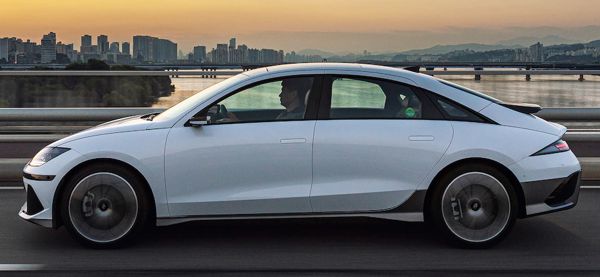 |
|
Extra-long
wheelbase offers ample rear legroom, but swoopy roofline compromises
headroom.
|
|
The rest of the car is more predictable. Basically, it shares the same
powertrain options with the Ioniq 5. You can have either single-motor /
rear-drive or dual-motor / AWD, and for the former a choice between
standard battery (58 kWh) or long range battery (77 kWh). 58 kWh RWD
model offers only 151 hp to push 1800 kg car thus takes 8.3 seconds to
go from 0-60 mph. 77 kWh RWD model improves that to 228 hp and 7
seconds. Long range AWD model uses 325 hp to propel the car from 0-60
in just under 5 seconds, which is very quick indeed. However, it weighs
as much as 2055 kg, and top speed of all models are regulated to the
same 115 mph. If you want true performance, you’ll need to wait for the
upcoming N model, which boasts 585 hp and should do 0-60 in about 3.5
seconds. It will be interesting to see it go against Mercedes-AMG
CLA45.
However, the aforementioned 382 miles range is reserved for only the
most efficient 77 kWh RWD model and fitted with 18-inch instead of the
pictured 20-inch wheels. An AWD model travels 60 miles shorter.
The driving experience is similar to Ioniq 5 as well. Smooth, easy and
refined. The AWD model offers strong acceleration, but the spaceship
soundtrack produced by loud speakers is best to be switched off. Brake
pedal feels a bit remote, but regenerative braking is smooth, and you
can adjust the level of regen with paddles. The body feels rigid,
steering is precise if not feelsome. One thing it improves markedly
from its crossover sister is body control, as its stiffer suspension
setup and lower center of gravity reduce body roll a lot, and
understeer is better suppressed in corner. It feels tauter and more
engaging to drive on challenging roads, if still not to be confused
with a driver’s car. Meanwhile, the car’s long wheelbase and hydraulic
bump stops keep the ride mostly agreeable.
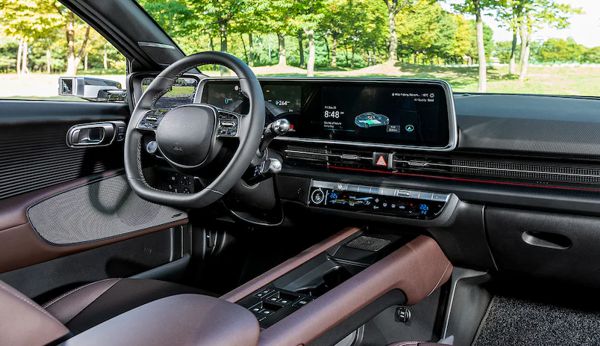
|
|
Cabin
is comfortable, stylish and modern.
|
|
The Ioniq 6’s cabin is spacious, mainly because it is a rather large
car – about as large as a Honda Accord, and boasts a longer wheelbase.
The flat cabin floor made possible by skateboard floorpan means rear
passengers are free from transmission tunnel. However, the swoopy
roofline does limit them to 6ft 2in tall, otherwise will find their
heads pressed against the roof liner. Those with big feet may also find
the space underneath front seats too tight, blame to the low mounting
of seats relative to the raised floor. The Hyundai is not as space
efficient as Tesla Model 3. Although its boot is reasonably sized,
access is made difficult by a narrow opening and high lip, while the
front boot is tiny to the extent of useless.
As in Ioniq 5, its cabin design is stylish and modern. The steering
wheel and many switchgears are shared between the two, as are the
12.3-in instrument and 12.3-in touchscreen infotainment system, but
they are housed in a classier-looking panel with metallic rim. In case
digital door mirror is optioned, an additional screen will be provided
at either ends of the dashboard. There is also color-changing LED
ambient lighting. Large door bins, plenty of oddity storage, wireless
charging and 5 USB ports provide plenty of convenience. Hyundai’s
infotainment system is among the best in mainstream brands, with a
relatively intuitive user interface and quick response. Although hard
plastics are plenty (especially the door panels), fit and finish is
good. Compare with Tesla Model 3, this is certainly a more interesting
and comfortable place to spend time.
However, competitive though it is, the Ioniq 6 is not the Tesla killer
we expected. Hyundai still needs to improve its EV platform, minimizing
the space it takes so that it won’t restrict styling. Before then, Kia
EV6 is still the best EV offering from the group, providing a more
stylish appearance and more practicality by its hatchback body.
|
Verdict:     |
|